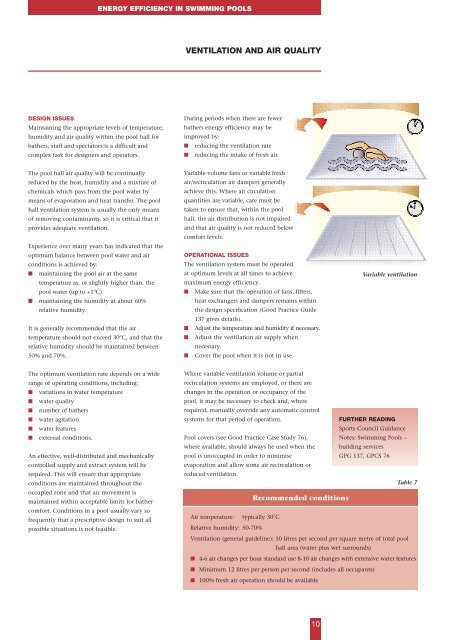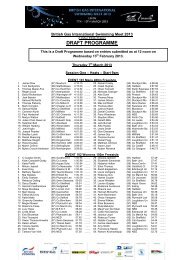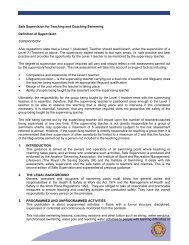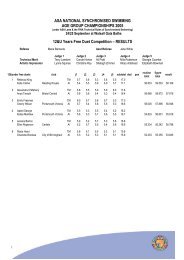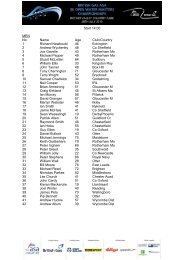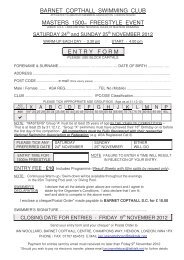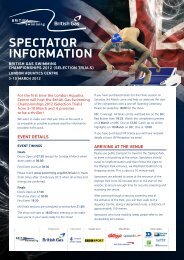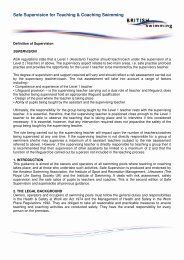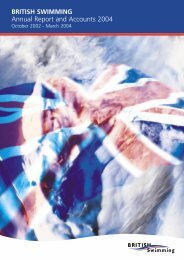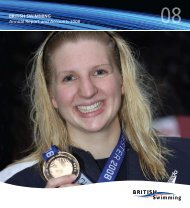Energy efficiency in swimming pools - Swimming.Org
Energy efficiency in swimming pools - Swimming.Org
Energy efficiency in swimming pools - Swimming.Org
Create successful ePaper yourself
Turn your PDF publications into a flip-book with our unique Google optimized e-Paper software.
DESIGN ISSUES<br />
Ma<strong>in</strong>ta<strong>in</strong><strong>in</strong>g the appropriate levels of temperature,<br />
humidity and air quality with<strong>in</strong> the pool hall for<br />
bathers, staff and spectators is a difficult and<br />
complex task for designers and operators.<br />
The pool hall air quality will be cont<strong>in</strong>ually<br />
reduced by the heat, humidity and a mixture of<br />
chemicals which pass from the pool water by<br />
means of evaporation and heat transfer. The pool<br />
hall ventilation system is usually the only means<br />
of remov<strong>in</strong>g contam<strong>in</strong>ants, so it is critical that it<br />
provides adequate ventilation.<br />
Experience over many years has <strong>in</strong>dicated that the<br />
optimum balance between pool water and air<br />
conditions is achieved by:<br />
■ ma<strong>in</strong>ta<strong>in</strong><strong>in</strong>g the pool air at the same<br />
temperature as, or slightly higher than, the<br />
pool water (up to +1ºC)<br />
■ ma<strong>in</strong>ta<strong>in</strong><strong>in</strong>g the humidity at about 60%<br />
relative humidity.<br />
It is generally recommended that the air<br />
temperature should not exceed 30ºC, and that the<br />
relative humidity should be ma<strong>in</strong>ta<strong>in</strong>ed between<br />
50% and 70%.<br />
The optimum ventilation rate depends on a wide<br />
range of operat<strong>in</strong>g conditions, <strong>in</strong>clud<strong>in</strong>g:<br />
■ variations <strong>in</strong> water temperature<br />
■ water quality<br />
■ number of bathers<br />
■ water agitation<br />
■ water features<br />
■ external conditions.<br />
An effective, well-distributed and mechanically<br />
controlled supply and extract system will be<br />
required. This will ensure that appropriate<br />
conditions are ma<strong>in</strong>ta<strong>in</strong>ed throughout the<br />
occupied zone and that air movement is<br />
ma<strong>in</strong>ta<strong>in</strong>ed with<strong>in</strong> acceptable limits for bather<br />
comfort. Conditions <strong>in</strong> a pool usually vary so<br />
frequently that a prescriptive design to suit all<br />
possible situations is not feasible.<br />
ENERGY EFFICIENCY IN SWIMMING POOLS<br />
VENTILATION AND AIR QUALITY<br />
Dur<strong>in</strong>g periods when there are fewer<br />
bathers energy <strong>efficiency</strong> may be<br />
improved by:<br />
■ reduc<strong>in</strong>g the ventilation rate<br />
■ reduc<strong>in</strong>g the <strong>in</strong>take of fresh air.<br />
Variable-volume fans or variable fresh<br />
air/recirculation air dampers generally<br />
achieve this. Where air circulation<br />
quantities are variable, care must be<br />
taken to ensure that, with<strong>in</strong> the pool<br />
hall, the air distribution is not impaired<br />
and that air quality is not reduced below<br />
comfort levels.<br />
OPERATIONAL ISSUES<br />
The ventilation system must be operated<br />
at optimum levels at all times to achieve<br />
maximum energy <strong>efficiency</strong>.<br />
■ Make sure that the operation of fans, filters,<br />
heat exchangers and dampers rema<strong>in</strong>s with<strong>in</strong><br />
the design specification (Good Practice Guide<br />
137 gives details).<br />
■ Adjust the temperature and humidity if necessary.<br />
■ Adjust the ventilation air supply when<br />
necessary.<br />
■ Cover the pool when it is not <strong>in</strong> use.<br />
Where variable ventilation volume or partial<br />
recirculation systems are employed, or there are<br />
changes <strong>in</strong> the operation or occupancy of the<br />
pool, it may be necessary to check and, where<br />
required, manually override any automatic control<br />
systems for that period of operation.<br />
Pool covers (see Good Practice Case Study 76),<br />
where available, should always be used when the<br />
pool is unoccupied <strong>in</strong> order to m<strong>in</strong>imise<br />
evaporation and allow some air recirculation or<br />
reduced ventilation.<br />
Recommended conditions<br />
10<br />
Variable ventilation<br />
FURTHER READING<br />
Sports Council Guidance<br />
Notes: Swimm<strong>in</strong>g Pools –<br />
build<strong>in</strong>g services<br />
GPG 137, GPCS 76<br />
Table 7<br />
Air temperature: typically 30˚C<br />
Relative humidity: 50-70%<br />
Ventilation (general guidel<strong>in</strong>e): 10 litres per second per square metre of total pool<br />
hall area (water plus wet surrounds)<br />
■ 4-6 air changes per hour standard use 8-10 air changes with extensive water features<br />
■ M<strong>in</strong>imum 12 litres per person per second (<strong>in</strong>cludes all occupants)<br />
■ 100% fresh air operation should be available


